
Ca' Rezzonico is a palazzo and art museum on the Grand Canal in the Dorsoduro sestiere of Venice, Italy. It is a particularly notable example of the 18th century Venetian baroque and rococo architecture and interior decoration, and displays paintings by the leading Venetian painters of the period, including Francesco Guardi and Giambattista Tiepolo. It is a public museum dedicated to 18th-century Venice and one of the 11 venues managed by the Fondazione Musei Civici di Venezia.

The Palazzo Vecchio is the town hall of Florence, Italy. It overlooks the Piazza della Signoria, which holds a copy of Michelangelo's David statue, and the gallery of statues in the adjacent Loggia dei Lanzi.

Giovanni Lanfranco was an Italian painter of the Baroque period.

Sabbioneta is a town and comune in the province of Mantua, Lombardy region, Northern Italy. It is situated about 30 kilometres (19 mi) north of Parma, not far from the northern bank of the Po River. It is one of I Borghi più belli d'Italia. It was inscribed in the World Heritage List in 2008.

The Palazzo Ducale di Mantova is a group of buildings in Mantua, Lombardy, northern Italy, built between the 14th and the 17th century mainly by the noble family of Gonzaga as their royal residence in the capital of their Duchy. The buildings are connected by corridors and galleries and are enriched by inner courts and wide gardens. The complex includes some 500 rooms and occupies an area of c. 34,000 m2, which make it the sixth largest palace in Europe after the palaces of the Vatican, the Louvre Palace, the Palace of Versailles, the Royal Palace of Caserta and the Castle of Fontainebleau. It has more than 500 rooms and contains seven gardens and eight courtyards. Although most famous for Mantegna's frescos in the Camera degli Sposi, they have many other very significant architectural and painted elements.

Bernadino Campi (1522–1591) was an Italian Renaissance painter from Cremona, who worked in Reggio Emilia. He is known as one of the teachers of Sofonisba Anguissola and of Giovanni Battista Trotti. In Cremona, his extended family owned the main artistic studios. Giulio Campi and Antonio Campi, half-brothers, were distant relatives of Bernardino; the latter is generally considered the most talented of the family. All were active and prominent painters locally. Influences on Bernardino include local Cremonese such as Camillo Boccaccino and artists from neighbouring regions such as Correggio, Parmigianino and Giulio Romano. He made a number of sets of copies of the Eleven Caesars by Titian, then in the Gonzaga collection, adding one of Domitian, which he based on a work by Giulio Romano. Titian's originals were all lost in an 18th-century fire in Madrid.
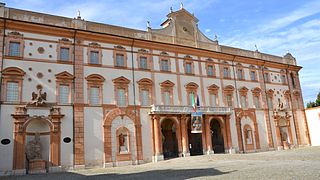
The Ducal Palace in Sassuolo is a Baroque villa located in the town of Sassuolo, thirty minutes outside Modena, northern Italy.

Lorenzo Leonbruno, also known as Lorenzo de Leombeni, was an Italian painter during the early Renaissance period. He was born in Mantua (Mantova), an Italian commune in Lombardy, Italy. Leonbruno is most well known for being commissioned by the court of Francesco Gonzaga, Marquis of Mantua, and his wife Isabella d'Este. The patronage continued with their eldest son Federico II Gonzaga, who was the fifth Marquis of Mantua. Leonbruno was the court painter for the Gonzaga family from 1506–24.

The Camera degli Sposi, sometimes known as the Camera picta, is a room frescoed with illusionistic paintings by Andrea Mantegna in the Ducal Palace, Mantua, Italy. During the fifteenth century when the Camera degli Sposi was painted, Mantua was ruled by the Gonzaga, who maintained Mantua's political autonomy from its much stronger neighbors Milan and Venice by bidding their support out as a mercenary state. By commissioning Mantegna to paint the chamber, Ludovico III Gonzaga, the Marquis of Mantua, sought to give the Gonzaga rule more cultural credibility at a time when other Northern Italian courts such as the Ferrara were commissioning their own “painted chambers”.

The Eleven Caesars was a series of eleven painted half-length portraits of Roman emperors made by Titian in 1536-1540 for Federico II, Duke of Mantua. They were among his best-known works, inspired by the Lives of the Caesars by Suetonius. Titian's paintings were originally housed in a new room inside the Palazzo Ducale di Mantova. Bernardino Campi added a twelfth portrait in 1562.

The Palazzo Grimani of Santa Maria Formosa is a State museum, located in Venice in the Castello district, near Campo Santa Maria Formosa.
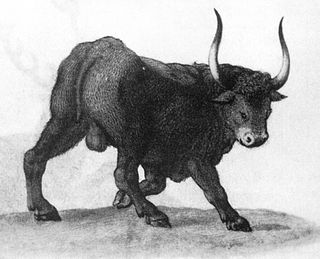
Teodoro Ghisi (1536–1601) was an Italian painter and engraver of the Renaissance Period, mainly active in his native Mantua. He specialized in paintings of animal and nature scenes.
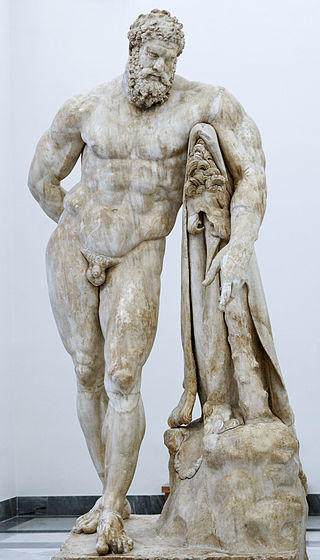
The classical sculptures in the Farnese Collection, one aspect of this large art collection, are one of the first collections of artistic items from Greco-Roman antiquity. It includes some of the most influential classical works, including the sculptures that were part of the Farnese Marbles, their collection of statuary, which includes world-famous works like the Farnese Hercules, Farnese Cup, Farnese Bull and the Farnese Atlas. These statues are now displayed in the Naples National Archaeological Museum in Italy with some in the British Museum in London.

Carlo Urbino (1525/30–1585) was an Italian painter of the Renaissance.

Frans Geffels, known in Italy as Francesco Geffels, was a Flemish painter, printmaker, architect, stage designer and designer of ephemeral structures for solemn and festive occasions. After training in his native Antwerp, he was mainly active in Mantua, where he was prefetto delle fabbriche to the Duke, a role that gave him the direction of the artistic and construction activities undertaken by the Ducal court. He worked also on projects for the local aristocratic class of Mantua. In addition, he completed projects for the Liechtenstein princes and for the imperial court in Vienna.
Rinaldo Mantovano, also called Domenico Rinaldo, was an Italian painter from Mantua who was active between 1527 and 1539. According to Giorgio Vasari he was the most talented assistant of Giulio Romano during his stay in the service of the Gonzaga Marquis' of Mantua.

San Paolo is a former convent in central Parma, Emilia-Romagna, northern Italy. It is best known for housing the Camera di San Paolo, decorated by a masterpiece of fresco work (1519) by Correggio.

The Camera di San Paolo or Camera della Badessa is a room in the former Monastery of San Paolo, in Parma, northern Italy. It is painted with frescoes by Correggio in the vault (697x645 cm) and over the fireplace.
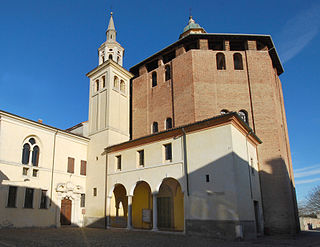
Beata Vergine Incoronata, or church of the Incoronata, is a renaissance-style, Roman Catholic church located in the town center of Sabbioneta, province of Mantua, region of Lombardy, Italy.
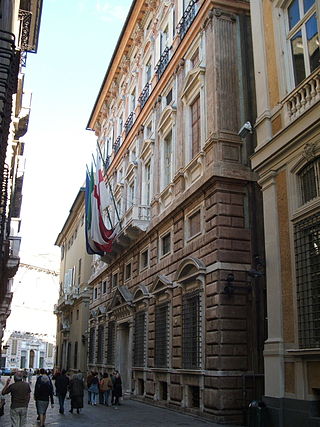
The Palazzo Carrega-Cataldi or Palazzo Tobia Pallavicino is a building located in via Garibaldi (Genoa) at number 4 in the historic centre of Genoa, included on 13 July 2006 in the list of the 42 palaces inscribed in the Rolli di Genova that became World Heritage by UNESCO on that date. The building is now the headquarters of Genoa's Chamber of Commerce.





















